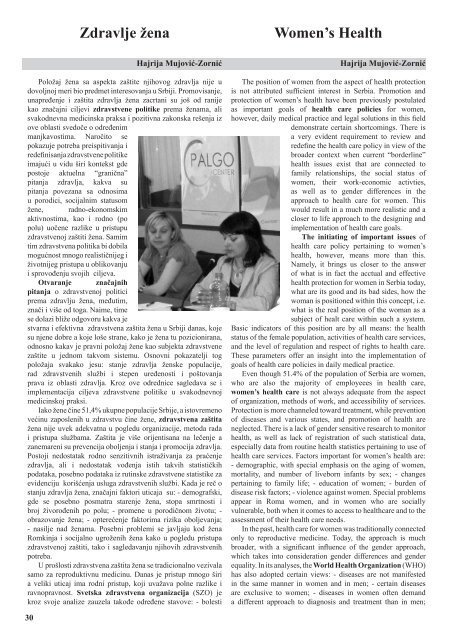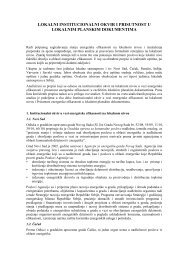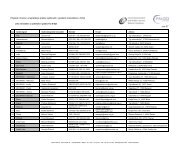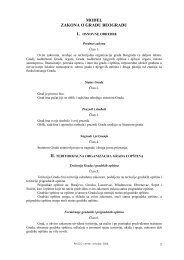Brošura u pdf. formatu - PALGO centar
Brošura u pdf. formatu - PALGO centar
Brošura u pdf. formatu - PALGO centar
You also want an ePaper? Increase the reach of your titles
YUMPU automatically turns print PDFs into web optimized ePapers that Google loves.
Zdravlje žena<br />
Women’s Health<br />
Hajrija Mujović-Zornić<br />
Položaj žena sa aspekta zaštite njihovog zdravlja nije u<br />
dovoljnoj meri bio predmet interesovanja u Srbiji. Promovisanje,<br />
unapređenje i zaštita zdravlja žena zacrtani su još od ranije<br />
kao značajni ciljevi zdravstvene politike prema ženama, ali<br />
svakodnevna medicinska praksa i pozitivna zakonska rešenja iz<br />
ove oblasti svedoče o određenim<br />
manjkavostima. Naročito se<br />
pokazuje potreba preispitivanja i<br />
redefinisanja zdravstvene politike<br />
imajući u vidu širi kontekst gde<br />
postoje aktuelna “granična”<br />
pitanja zdravlja, kakva su<br />
pitanja povezana sa odnosima<br />
u porodici, socijalnim statusom<br />
žene, radno-ekonomskim<br />
aktivnostima, kao i rodno (po<br />
polu) uočene razlike u pristupu<br />
zdravstvenoj zaštiti žena. Samim<br />
tim zdravstvena politika bi dobila<br />
mogućnost mnogo realističnijeg i<br />
životnijeg pristupa u oblikovanju<br />
i sprovođenju svojih ciljeva.<br />
Otvaranje značajnih<br />
pitanja o zdravstvenoj politici<br />
prema zdravlju žena, međutim,<br />
znači i više od toga. Naime, time<br />
se dolazi bliže odgovoru kakva je<br />
stvarna i efektivna zdravstvena zaštita žena u Srbiji danas, koje<br />
su njene dobre a koje loše strane, kako je žena tu pozicionirana,<br />
odnosno kakav je pravni položaj žene kao subjekta zdravstvene<br />
zaštite u jednom takvom sistemu. Osnovni pokazatelji tog<br />
položaja svakako jesu: stanje zdravlja ženske populacije,<br />
rad zdravstvenih službi i stepen uređenosti i poštovanja<br />
prava iz oblasti zdravlja. Kroz ove odrednice sagledava se i<br />
implementacija ciljeva zdravstvene politike u svakodnevnoj<br />
medicinskoj praksi.<br />
Iako žene čine 51,4% ukupne populacije Srbije, a istovremeno<br />
većinu zaposlenih u zdravstvu čine žene, zdravstvena zaštita<br />
žena nije uvek adekvatna u pogledu organizacije, metoda rada<br />
i pristupa službama. Zaštita je više orijentisana na lečenje a<br />
zanemareni su prevencija oboljenja i stanja i promocija zdravlja.<br />
Postoji nedostatak rodno senzitivnih istraživanja za praćenje<br />
zdravlja, ali i nedostatak vođenja istih takvih statističkih<br />
podataka, posebno podataka iz rutinske zdravstvene statistike za<br />
evidenciju korišćenja usluga zdravstvenih službi. Kada je reč o<br />
stanju zdravlja žena, značajni faktori uticaja su: - demografski,<br />
gde se posebno posmatra starenje žena, stopa smrtnosti i<br />
broj živorođenih po polu; - promene u porodičnom životu; -<br />
obrazovanje žena; - opterećenje faktorima rizika oboljevanja;<br />
- nasilje nad ženama. Posebni problemi se javljaju kod žena<br />
Romkinja i socijalno ugroženih žena kako u pogledu pristupa<br />
zdravstvenoj zaštiti, tako i sagledavanju njihovih zdravstvenih<br />
potreba.<br />
U prošlosti zdravstvena zaštita žena se tradicionalno vezivala<br />
samo za reproduktivnu medicinu. Danas je pristup mnogo širi<br />
a veliki uticaj ima rodni pristup, koji uvažava polne razlike i<br />
ravnopravnost. Svetska zdravstvena organizacija (SZO) je<br />
kroz svoje analize zauzela takođe određene stavove: - bolesti<br />
Hajrija Mujović-Zornić<br />
The position of women from the aspect of health protection<br />
is not attributed sufficient interest in Serbia. Promotion and<br />
protection of women’s health have been previously postulated<br />
as important goals of health care policies for women,<br />
however, daily medical practice and legal solutions in this field<br />
demonstrate certain shortcomings. There is<br />
a very evident requirement to review and<br />
redefine the health care policy in view of the<br />
broader context when current “borderline”<br />
health issues exist that are connected to<br />
family relationships, the social status of<br />
women, their work-economic activties,<br />
as well as to gender differences in the<br />
approach to health care for women. This<br />
would result in a much more realistic and a<br />
closer to life approach to the designing and<br />
implementation of health care goals.<br />
The initiating of important issues of<br />
health care policy pertaining to women’s<br />
health, however, means more than this.<br />
Namely, it brings us closer to the answer<br />
of what is in fact the acctual and effective<br />
health protection for women in Serbia today,<br />
what are its good and its bad sides, how the<br />
woman is positioned within this concept, i.e.<br />
what is the real position of the woman as a<br />
subject of healt care within such a system.<br />
Basic indicators of this position are by all means: the health<br />
status of the female population, activities of health care services,<br />
and the level of regulation and respect of rights to health care.<br />
These parameters offer an insight into the implementation of<br />
goals of health care policies in daily medical practice.<br />
Even though 51.4% of the population of Serbia are women,<br />
who are also the majority of employeees in health care,<br />
women’s health care is not always adequate from the aspect<br />
of organization, methods of work, and accessibility of services.<br />
Protection is more channeled toward treatment, while prevention<br />
of diseases and various states, and promotion of health are<br />
neglected. There is a lack of gender sensitive research to monitor<br />
health, as well as lack of registration of such statistical data,<br />
especially data from routine health statistics pertaining to use of<br />
health care services. Factors important for women’s health are:<br />
- demographic, with special emphasis on the aging of women,<br />
mortality, and number of liveborn infants by sex; - changes<br />
pertaining to family life; - education of women; - burden of<br />
disease risk factors; - violence against women. Special problems<br />
appear in Roma women, and in women who are socially<br />
vulnerable, both when it comes to access to healthcare and to the<br />
assessment of their health care needs.<br />
In the past, health care for women was traditionally connected<br />
only to reproductive medicine. Today, the approach is much<br />
broader, with a significant influence of the gender approach,<br />
which takes into consideration gender differences and gender<br />
equality. In its analyses, the World Health Organization (WHO)<br />
has also adopted certain views: - diseases are not manifested<br />
in the same manner in women and in men; - certain diseases<br />
are exclusive to women; - diseases in women often demand<br />
a different approach to diagnosis and treatment than in men;<br />
30

















